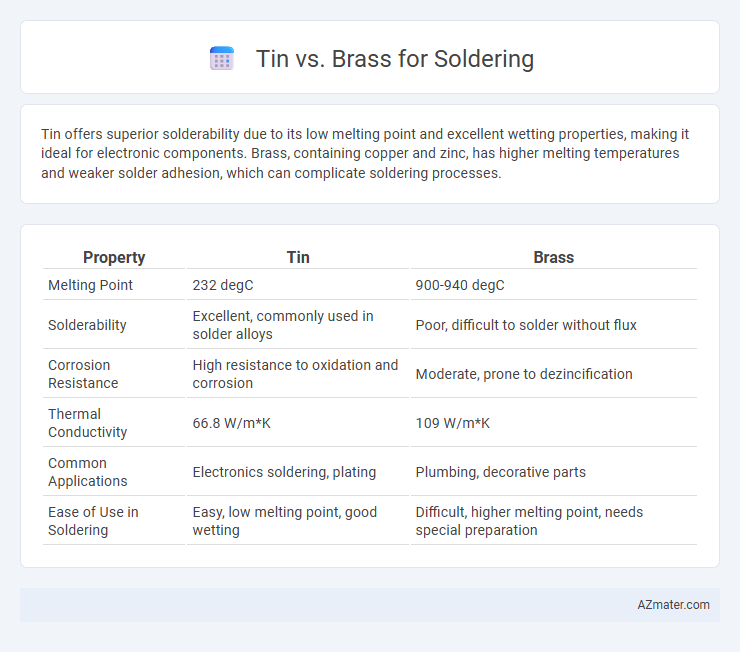Tin offers superior solderability due to its low melting point and excellent wetting properties, making it ideal for electronic components. Brass, containing copper and zinc, has higher melting temperatures and weaker solder adhesion, which can complicate soldering processes.
Table of Comparison
| Property | Tin | Brass |
|---|---|---|
| Melting Point | 232 degC | 900-940 degC |
| Solderability | Excellent, commonly used in solder alloys | Poor, difficult to solder without flux |
| Corrosion Resistance | High resistance to oxidation and corrosion | Moderate, prone to dezincification |
| Thermal Conductivity | 66.8 W/m*K | 109 W/m*K |
| Common Applications | Electronics soldering, plating | Plumbing, decorative parts |
| Ease of Use in Soldering | Easy, low melting point, good wetting | Difficult, higher melting point, needs special preparation |
Introduction: Tin vs Brass in Soldering
Tin and brass exhibit distinct properties influencing their suitability in soldering applications, with tin being a soft, malleable metal renowned for excellent solderability due to its low melting point and strong affinity for solder alloys. Brass, an alloy of copper and zinc, offers higher strength and corrosion resistance but poses challenges during soldering because of its oxide layer and higher thermal conductivity, which can affect heat transfer and joint quality. Choosing between tin and brass for soldering depends on the specific requirements of mechanical strength, electrical conductivity, and durability in the final assembly.
Material Properties: Tin and Brass Compared
Tin exhibits excellent solderability due to its low melting point of 232degC and its ability to form strong metallurgical bonds, making it ideal for delicate electronic components. Brass, an alloy primarily of copper and zinc, has a higher melting point around 900-940degC and lower solderability, often requiring flux and higher temperatures to ensure proper joint formation. The softness and oxidation resistance of tin enhance solder joint reliability, whereas brass's hardness and corrosion resistance make it suitable for mechanical strength but more challenging to solder effectively.
Melting Points and Solderability
Tin offers a lower melting point around 232degC compared to brass, which melts between 900degC and 940degC, making tin-based solders more suitable for delicate electronic components. The superior solderability of tin stems from its ability to form reliable metallurgical bonds with copper and other common metals used in circuit boards. Brass, being an alloy of copper and zinc with a high melting point, is less favorable for soldering applications due to the risk of heat damage and poor wetting characteristics.
Electrical Conductivity Differences
Tin and brass exhibit significant differences in electrical conductivity that impact their performance in soldering applications. Tin, with a higher electrical conductivity of approximately 9.17 million S/m, enables better current flow, making it ideal for creating efficient electrical connections in solder joints. Brass, an alloy of copper and zinc, has lower conductivity around 15 million S/m but varies widely based on composition, often leading to less efficient electrical performance compared to pure tin solder materials.
Thermal Conductivity in Soldering Applications
Tin exhibits lower thermal conductivity compared to brass, typically around 66 W/m*K versus brass's 109 W/m*K, which influences heat distribution during soldering. Brass's higher thermal conductivity allows for faster heat transfer, reducing soldering time but increasing the risk of overheating adjacent components. Selecting tin-based solders helps achieve precise thermal control in delicate electronics, while brass fittings require careful temperature management to prevent thermal damage.
Corrosion Resistance: Tin vs Brass
Tin offers superior corrosion resistance for soldering applications compared to brass, as it forms a protective oxide layer that prevents further oxidation and degradation. Brass, an alloy of copper and zinc, is more prone to dezincification and surface corrosion when exposed to moisture and acids. Choosing tin-based solders enhances joint durability and reliability in corrosive environments.
Mechanical Strength and Durability
Tin solder offers excellent mechanical strength due to its flexibility and ability to create strong, reliable joints, but it may exhibit lower durability under mechanical stress compared to brass. Brass, an alloy of copper and zinc, provides superior durability and resistance to wear and corrosion in soldered connections, making it ideal for applications requiring long-term mechanical stability. Choosing between tin and brass solder depends on the specific demands of mechanical strength and environmental durability required for the project.
Cost Considerations for Soldering Materials
Tin solder is generally more cost-effective due to its widespread availability and lower market price compared to brass. Brass, often used as a base metal rather than solder, incurs higher costs when alloyed or coated for soldering applications because of its copper and zinc content. Choosing tin solder reduces overall expenses while ensuring reliable joint strength and conductivity in electronic and plumbing projects.
Best Use Cases: When to Use Tin or Brass
Tin solder excels in electronics and electrical applications due to its low melting point and excellent conductivity, making it ideal for delicate circuit boards and wiring connections. Brass, with its higher strength and durability, suits plumbing, mechanical joints, and decorative metalwork where structural integrity and corrosion resistance are crucial. Choosing tin is best for precision electrical soldering, while brass is preferred for robust, load-bearing soldered assemblies.
Conclusion: Choosing the Optimal Material for Soldering
Tin offers excellent solderability with low melting points, making it ideal for intricate electronics and fine joints, while brass provides superior mechanical strength and corrosion resistance but requires higher soldering temperatures. Choosing between tin and brass depends on the specific application requirements such as thermal sensitivity, joint durability, and environmental exposure. For optimal soldering performance, tin-based alloys are preferred for electrical conductivity and ease of use, whereas brass is chosen when structural integrity and wear resistance are prioritized.

Infographic: Tin vs Brass for Soldering
 azmater.com
azmater.com